Translated by Nick R
As you know, all plant species are unique and gorgeous, and they offer so many benefits that we cannot mention them enough. On this occasion, I’d like to introduce the awesome begonias.
These plants are used, mostly, to decorate interiors, terraces, galleries, or to compose parterres and embroideries. The begonias’ variety of species has distinctive characteristics regarding color, flowering, size, and leaf and flower size.
Would you like to know a little more about these magnificent plants? Then stay, in this blog, you’ll get to know the botanical features of begonias, the existing species, where you can place them, and how to plant and care for them.
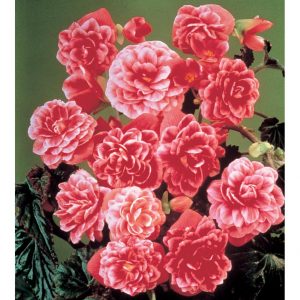
Table of Contents
Characteristics of begonias
As I mentioned at the beginning, begonia species have various morphological characteristics. Moreover, they’re cultivated considering the intended use or the part of the plant that is to be emphasized.
These plants belong to the Begonia family which consists of approximately 1000 species and 15000 hybrids and varieties. Begonias owe their origin to the tropical and subtropical areas of Asia, Africa, and America, as these are warm and humid regions. However, begonias can also thrive in cool and arid environments.
Begonias can be either perennial or deciduous. Among the latter, tuberous begonias stand out as when they lose their leaves, renewing the vegetation growth relies on the tuber (part of the subway stem).
Some tuberous begonias can be of rhizome (horizontal subterranean stem) or fasciculate root (root formed by a bunch of secondary roots).
Below, I’ll explain the morphology of these beautiful plants to understand why they are so appreciated.
The Begonia leaves
The leaves of begonias can have different shapes: rounded, oval, or elongated, as well as asymmetrical. This condition is found in most species and varieties of begonias.
The leaves of begonias have a variety of colors that can go from white to silver-gray, pink, red, violet, black and brown. They also come in different shades of green with stripes, spots, dots, and other shapes. Even the top and bottom of the leaf can be colored differently. Isn’t that amazing?
As for the leaf edges, their features can also vary as some are more or less serrated, smooth, or lobed. Likewise, its surface has different textures: hairy, grainy, wrinkled, flaky, or smooth.

The Begonia flowers
Begonias have both male and female flowers, which, although separate, are found on the same inflorescence in most species. The female flower is usually at the end of the stem while the male is located at the sides of it.
The male flora, which has 2 petals of smaller size than the rest, is more visible in begonias. These flowers have multiple stamens (elongated strands) organized in 4 groups, also called whorls. In these stamens can be found the yellow anthers, which are located at the tip and are responsible for carrying the pollen. Its flowering lasts less, yet it’s very showy.
These features are a little different in the female flower, as all its petals are of equal length, have a longer flowering period, and pale colors. However, both types of flowers have very different colors and shapes.
Begonias are a plant genus with a greater possibility of color and shape variation. For example, spontaneous species have flowers called false umbels (open or clustered inflorescence type). These flowers can be straight or slanting and have an appearance like coral tentacles, with various colors.
Normally, the begonias flowers are simple and have 4 petals, although, in commercial varieties, double flowers can be found. Species such as Begonia x hiemalis have flowers similar to those of a rose bush, dahlia, or anemone.
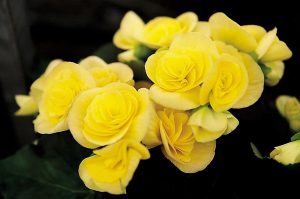
The Begonia roots
There are 3 types of roots in begonias. The first type is the tuber, which involves the transformation of a small portion of the underground stem and contains closely packed buds or shoots. This type serves not only as a root but also is capable of storing various reserve substances to be used for several years.
The second type is the rhizome, which resembles a stem and is considered as such and can elongate underground. Pieces to reproduce the plant can be taken from this type of root.
The third type is fasciculate roots which, as mentioned above, consist of one main root and several lateral roots that can generally develop on the surface; they are thin and fibrous.
9 outstanding species of begonias
As I have already mentioned, the genus of begonias includes several species that catch the eye due to their size, dimensions, and the possibility of using them inside or outside the home.
On this occasion, I’m going to show you some of these species classified into the following categories based on their esthetics:
- Flower Begonia
- Begonia with decorative foliage: its value as ornament is found in the leaves. They are used for interiors and have a hanging or upright habit.
- Shrubby Begonias: these plants have an upright and hanging habit, as well as an abundant and prolonged flowering based on their variety.
| Flower Begonia | Description |
| Begonia semperflorens | This group of begonias is ideal for decorating flowerbeds and gardens, as well as for forming borders, planting in pots and creating colorful tapestries. It’s a hardy, vigorous species, with an abundant bloom from mid-spring to late fall. It grows compactly. It’s an annual because it does not tolerate very intense winter cold. Its small flowers can be single or double and white, pink or even bicolor with a white center. Its leaves have various shades ranging from green, purple, bronze or red wine. These leaves give the plant a very striking aesthetic appearance. |
| Begonias tuberosas | Its main feature is the presence of a 15 to 18 cm circumference tuber whose color is red. Depending on the variety of the plant, the stems are fleshy and can be hanging, straight or compact. The leaves of this species are very diverse, they can be covered with hair, naked, with smooth or trimmed edges and with or without petiole (corner that joins the leaf blade to the leaf base or stem). It has separate male and female flowers but is located on the same plant. They can reach up to 20 cm in diameter and are of very varied colors. They are the most used plants for indoor decorations, gardens and terraces for the beauty and size of its flowers and the variety of colors it has. Its flowers can be simple or double and depending on the variety, they can be very showy and have a large size. |
| Begonia x hiemalis | This species is obtained by hybridization between Begonia socotrana and Begonia tuberhybrida. It’s commonly used indoors, but it can also be outdoors in a shady place protected from the wind. Naturally, their flowering is winter, however, when they are marketed their flowering lasts all year long. This is because florists manipulate the balance between vegetative development and flowering time. The flowers of this species can be single or double and are white in color, but have various shades such as pink, yellow, orange and red. They have a smooth or trimmed edge and a medium size. There are many varieties of this species, the one pictured here is a yellow ochre-colored Begonia x hiemalis Katrin. |
| Decorative foliage Begonia | Description |
| Begonia rex | They’re the best known in this category and the most demanding, as they require a space that is warm and humid. They’re native to India and have the characteristic that their leaves are deep green and silver at the edges. Depending on the hybrids of this species, the characteristics of the foliage can vary in coloration. You can find them from silver to red to light green. |
| Begonia masoniana | This plant is covered with hair, has a rhizome root, triangular and thick leaves and inconspicuous flowers. It’s also known as iron cross because of the drawing that has been captured in its characteristic and very striking leaf. |
| Begonia feastii | This is a dwarf hybrid with red leaves and hairs on the lower part. Its flowers are small in size and are grouped in panicles, that is, in the form of a cluster. They’re easy to care for and bring a spectacular ornamental view to your home. |
| Shrubby Begonias | Description |
| Begonia x corallina | This species of Brazilian origin is very vigorous. In addition, its leaves are mottled, that is, they’re dotted with white dots and are red on the underside. The variety shown in the picture is called Lucerna and has deep pink flowers, which are grouped in panicles. |
| Begonia metallica | This species of begonia blooms in early autumn and its flowers have a dark pink color. It’s a plant that can grow up to 1 meter. Its name alludes to the appearance of its leaves, as they have metallic reflections and are grayish green with red veins. The flowers are covered with pink and red hairs. |
| Begonia foliosa miniata | It’s also known as Begonia fuchsia and can bloom from mid-winter to mid-spring. The color of its flowers can vary from scarlet red to light pink. It’s a very showy plant and appreciated for the beauty it has and the upright and branched bearing from the base. |
Where to place the begonias
Now that we know a little about the characteristics of these beautiful plants and some of their most striking species, let me tell you about the best places to place them. This way, you’ll be able to enjoy their beauty and provide any space with a stunning view.
Begonias in gardens
Most begonia species can be planted outdoors in the garden; however, there are exceptions, such as Begonia rex and rhizomatous begonia. The latter requires a warm and humid location and doesn’t withstand harsh winters.
To create beds (strips of land to grow plants) and borders (plants for the edges of the garden), you can use Begonias semperflorens as they flower for a long time.
As it is a species with a great variety of colors, you can use the same shade as salmon pink or light pink. Or also combine shaded colors with white, light or dark pink, and red.
As you know, begonias’ leaves are also ornamental, so they bring life to the flower bed. Also, you can use begonias to create a tapestry at the base of trees and shrubs.
A tip is not to combine begonias and flowering shrubs; there may be an interference in terms of colors and shapes so that the aesthetics of either species couldn’t be appreciated. Make sure the shrubs are green-leaved, perennial, or deciduous.
You can use any begonia species such as tuberous, shrubby, and ornamental foliage. Most importantly is determining where in the garden you’d like to incorporate them into, taking into account their needs. Avoid them being camouflaged by other plants and give them a location to stand out. – You won’t regret it.

Begonias on terraces
The same species that I mentioned for gardens can be used for terraces. What you must keep in mind is they should be planted in pots or other containers. That’s because a terrace doesn’t have the same space as a garden.
You can also create compositions with flowering begonias and other green plants. These will help brighten up the terrace or balcony, as you can play with various colors or simply keep the composition monochromatic.
Tuberous hanging begonias are perfect for planting in hanging pots. In addition, you can partner begonias with green plants such as ivy with small green or shaded leaves. They’ll look spectacular.
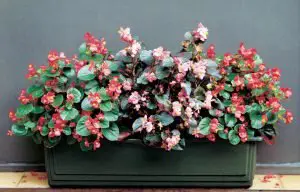
Begonias indoors
Begonias with ornamental foliage and Begonias x hiemalis are suitable for any part of your home or anywhere else. It’s best to keep these species in pots or other containers so that the decorative impact of the leaves can be highlighted.
On this occasion, I advise you not to combine the ornamental foliage begonias with other species of plants, as I said before, the idea is to highlight the decorative look of the begonias. Make sure that the pots you’re using are wide and low, so that the plant will have enough space.
Begonias x hiemalis can be part of compositions with other plant species with decorative foliage and flowers, or if you prefer, leaving them alone is also valid.
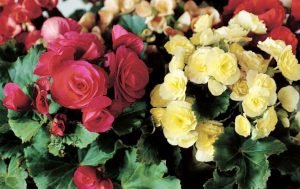
Planting process for begonias
Now, I’ll explain the propagation methods of begonias and the steps to follow to plant them correctly.
Apical cuttings
We start with the most common and well-known method, which consists of cutting a shoot from the mother plant of approximately 6 to 8 cm (3 to 4 inches). Ideally, the cutting should have 2 leaf nodes, which are the areas where the leaves are born, and the cut should be made just below the first node.
Subsequently, remove the base leaves and any flowers that the bud may have. This will allow it to concentrate only on root development. Similarly, you can stimulate the rooting of the cutting by using homemade rooting agents.
Once the sprout is ready to be planted, place it in a small container or in the area where you’ll allow it to grow definitively. For doing so, make a small hole in the soil, insert the cutting and give it a good splash of water.
Remember that, humidity is a fundamental factor, so you can cover the pot with transparent plastic or use a plastic bottle, as explained in the blog of helpful things for your garden with recycled materials.
Ideally, you should remove the plastic or bottle every day for a few minutes to avoid excess humidity. After 3 weeks, you can completely remove these elements because the sprout will have already developed roots and will be strong enough. Moreover, you’ll see that the plants obtained from an apical cutting are very vigorous and grow quickly.
This procedure is perfect for Begonias x hiemalis and bushy plants.
Foliar cuttings
That’s right, begonias can also be multiplied by means of their leaves; however, their growth is much slower than in the previous method.
For this method, you must take a whole leaf from the mother plant and then sink it slightly into the soil where it joins the stem. That is to say, the leaf should be vertical. Therefore, I recommend placing 2 leaves, one against the other so they support each other, and thus prevent them from touching the soil and rotting.
After 5 weeks, a few roots will have emerged from the planted leaves, and over time, a new begonia plant will grow. The cuttings should not be exposed to direct sunlight during the growing season; however, they need plenty of light and a constantly moist substrate.
Tuber division
This method applies to tuberous begonias and consists of dividing or separating the tuber into several pieces with at least 1 bud.
You can do this process only with your hands so as to be more careful with the roots. In the case of a well-developed adult plant, you can help yourself with a disinfected knife.
Then, plant the divisions in separate containers or allow a distance of approximately 30 cm (12 in.) between them. Finally, do not forget to water each plant to relieve stress on the roots caused by transplanting.
Rhizome division
This option requires practically the same steps as multiplication by apical cutting but is carried out on Begonias rex, rhizomatous, and ornamental foliage Begonias.
You need to cut the ends of the central part of the rhizome, making sure that it has at least 2 nodes and 1 leaf. Afterward, sow each division and follow the tips I gave you in the first method of multiplication in this list.
Remember that rhizomes are robust stems that emit roots and herbaceous shoots. Next, I’ll share with you an illustrative image to understand better what they look like and how the division is done.
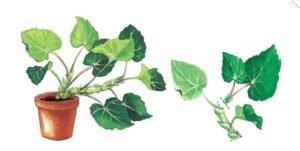
Planting
Begonias need a mild climate, which is why it’s advisable to plant them in late spring when there is no risk of low temperatures or frost.
Before starting the planting, whether you bought a seedling in a nursery or you’re going to transplant it, you need the necessary elements ready so that the plant is exposed to the open air as little as possible.
That said, for potting, I advise you to place a layer of gravel or expanded clay at the bottom of the container to promote drainage and prevent direct contact between the roots and the water. In addition, the pot doesn’t need to be very deep, roots don’t advance deeply, but expand out to the sides.
When you have finished arranging the plant, water the substrate thoroughly to settle it, and as it’s likely to descend, add a little more soil.
For planting in the garden, make a hole in the soil proportionate to the size of the root ball, add a little soil and place a layer of compost or mulch. In this way, you’ll keep a constant humidity level. However, keep in mind that with mulch, watering will be less frequent.
Finally, begonias bloom in spring and summer, except for the tuberous socotrana species, which bloom in winter.
Care of begonias
Finally, I’m going to show you the specific care that this type of plant needs for successful cultivation.
Light exposure
Begonias enjoy good lighting, but only a few varieties. Like Begonias semperflorens, it can tolerate direct sunlight. So choose an area where your plants will be in partial shade or filtered sunlight, preferably in morning sun and afternoon shade.
The ornamental foliage group of begonias, such as Begonia rex, is excellent as a houseplant because it prefers semi-shade. While, those of shrubby behavior, love intense light.
Soil
They can be grown in garden soil or in pots, using a light, moist, but well-drained substrate. So, you can implement a universal substrate and fortify it with organic matter to provide a few nutrients.
Watering
Ideally, the soil should always be slightly moist, but not too much as these plants are pretty sensitive to watering and excess moisture thus they can rot. For this reason, you should avoid spraying the foliage and water only the soil.
A tip I can give you is to use pots with drainage holes and place a tray with water underneath. By doing this, the roots will be in contact with the moisture that rises from the bottom to the top, without receiving water directly.
Now, it’s best to water in the morning so that the soil dries out before nightfall when the temperature is lower. Besides, it’s better to water thoroughly but less frequently, rather than superficially and with more consistency.
Fertilization
Begonias are undemanding when it comes to nutrients, but proper feeding will encourage vegetation and flowering. For this purpose, you can use fertilizers with macronutrients such as nitrogen (N), phosphorus (P), and potassium (K).
During the growth period, it’s advisable to use liquid fertilizers, which can be included in the irrigation water, as well as fertilizing more frequently, but in low doses. If you’re looking for specific suggestions, we have a blog with the most recommended chemical fertilizers in nurseries.
Pruning
Pruning is done most often on shrub begonias, and its purpose is to remove dry or diseased parts and reshape the plant.
If we talk about ornamental foliage varieties, pruning can help remove small flowers that restrict the formation and growth of new leaves. While in the case of Begonias semperflorens, the first flowering flowers can also be cut off to encourage the growth of new flower buds.
Transplanting of Begonias
You’ll know it’s time for transplanting when the roots have spread throughout the container and have run out of space. Since they’re fragile, as are the stems, you must be careful when handling the plant.
Keep in mind that Begonias x hiemalis and semperflorens are not usually transplanted as they are generally annual species. Begonias rex and shrubs, on the other hand, are commonly transplanted in spring, when the roots become too thick for their initial pot.
Pests and diseases of Begonias
Begonias are susceptible to the presence of pests and diseases; however, keep in mind that a healthy, well-fed plant will be less exposed and will have greater strength to overcome small attacks.
To be more specific, they’re sensitive to pests such as aphids, whiteflies, thrips, and spider mites. On the other hand, it can present diseases such as powdery mildew, mosaic virus, and stem or flower rot.
In case your plants are infested, I advise you to use organic insecticides such as neem oil and potassium soap. This is because chemical insecticides can be toxic to Begonias, especially when in the flowering season.
____________________________________________
As you’ve seen, begonias are plants that provide us with great diversity, and although certain care may vary depending on the species, they are easy to grow and maintain.
That said, I hope this blog has moved you to get a begonia in your home, and you’ve learned all about its characteristics, propagation methods, and care. In this way, I know, for sure, that you’ll have a successful crop.


